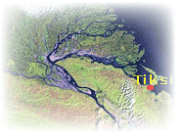ESRL to Host International Planning Meeting for Siberian Arctic Observatory
February 21, 2007
 The NOAA Earth System Research Laboratories will host an international
meeting, March 7-9, 2007, in Boulder, CO, to develop further plans for the
new Intensive Arctic Observatory, Tiksi, Russia, located at the mouth of
the Lena River on the Arctic coast of Russia. This observatory is a
partnership between NOAA, NSF, NASA, and the Russian Federal Service for
Hydrometeorology and Environmental Monitoring (Roshydromet) and will
support international research across scientific disciplines, but with a
focus on issues related to climate change in the Arctic. The station will
become part of a network of intensive Arctic observatories in the U.S.,
Canada, Norway, Greenland and Finland that measure trace gases, air
pollutants, radiation, clouds and aerosols as well as meteorology. Meeting
participants are coming from the U.S., Russia, Finland, Canada, and Japan.
The Russian delegation will include engineers from Tiksi, and managers and
scientists from the Moscow and Yakutsk Roshydromet offices. The Tiksi
engineers will be trained to use trace gas flask sampling equipment and
continuous ozone monitors which will be the first sets of equipment
deployed to Tiksi by NOAA. The goal will be to have the Tiksi Observatory
support a number of global monitoring networks such as Global Atmosphere
Watch (GAW), Baseline Surface Radiation Network (BSRN), Micropulse Lidar
Network (MPLnet), the Ultraviolet Network (UVnet), the Climate Reference
Network (CRN), the Aerosol Network (AERONET) program and the developing
U.S. Arctic Observing Network (AON).
The NOAA Earth System Research Laboratories will host an international
meeting, March 7-9, 2007, in Boulder, CO, to develop further plans for the
new Intensive Arctic Observatory, Tiksi, Russia, located at the mouth of
the Lena River on the Arctic coast of Russia. This observatory is a
partnership between NOAA, NSF, NASA, and the Russian Federal Service for
Hydrometeorology and Environmental Monitoring (Roshydromet) and will
support international research across scientific disciplines, but with a
focus on issues related to climate change in the Arctic. The station will
become part of a network of intensive Arctic observatories in the U.S.,
Canada, Norway, Greenland and Finland that measure trace gases, air
pollutants, radiation, clouds and aerosols as well as meteorology. Meeting
participants are coming from the U.S., Russia, Finland, Canada, and Japan.
The Russian delegation will include engineers from Tiksi, and managers and
scientists from the Moscow and Yakutsk Roshydromet offices. The Tiksi
engineers will be trained to use trace gas flask sampling equipment and
continuous ozone monitors which will be the first sets of equipment
deployed to Tiksi by NOAA. The goal will be to have the Tiksi Observatory
support a number of global monitoring networks such as Global Atmosphere
Watch (GAW), Baseline Surface Radiation Network (BSRN), Micropulse Lidar
Network (MPLnet), the Ultraviolet Network (UVnet), the Climate Reference
Network (CRN), the Aerosol Network (AERONET) program and the developing
U.S. Arctic Observing Network (AON).
Background:
The establishment of the Tiksi observatory was initiated as part of the U.S
Study of Environmental Arctic Change (SEARCH) program. A full complement of
instruments will acquire long-term records of cloud and aerosol properties,
trace gas concentrations, radiative fluxes and surface energy exchanges to
facilitate the understanding of climate change in the Arctic. NSF replaced
the existing weather station in Tiksi in the summer/fall of 2006 (at a cost
of $500k) with a new, modern research building, which has laboratory and
roof space intended to support research instrumentation. Present plans are
to build a second "Clean Air" building 1.5 km upwind of the present
facility in the summer of 2007. This building, also funded by NSF, is
expected to cost an additional $500k.
Significance:
Climate warming in the Arctic could potentially melt permafrost releasing
huge amounts of carbon dioxide and methane, the most powerful greenhouse
gases. Some of the largest reservoirs of peat, which is high in carbon, are
located in the Arctic coastal plain of Siberia. Early detection of these
releases will be possible from the measurements taken at the Tiksi station.
The station will become part of the U.S. - Russian Climate Bilateral
Agreement and will be discussed at an ambassadorial-level meeting in
Washington, DC April 11-12, 2007, and at a U.S. - Russian Joint
Coordinating Committee Meeting on Cooperation in the field of World Oceans
and Polar Regions with the Russian Academy of Sciences, May 15-16, 2007, in
Silver Spring, MD. This later meeting will be co-chaired by Dr. Richard
Spinrad, Assistant Administrator, OAR. These activities support NOAA's
mission goal of understanding climate variability and change to enhance
society's ability to plan and respond, as well as the cross-cutting
priority of international cooperation and collaboration.
| Contact: Taneil Uttal | More Information: |